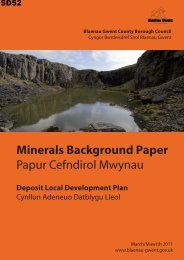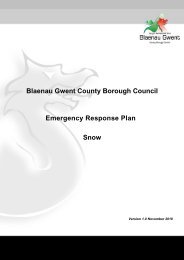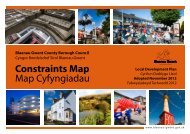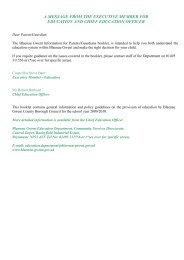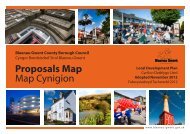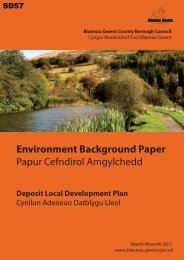Planning Policy Wales - Brecon Beacons National Park
Planning Policy Wales - Brecon Beacons National Park
Planning Policy Wales - Brecon Beacons National Park
Create successful ePaper yourself
Turn your PDF publications into a flip-book with our unique Google optimized e-Paper software.
13.1 Objectives<br />
13.1.1 <strong>Planning</strong> and environmental management are separate but complementary. By controlling<br />
where development can take place and what operations may be carried out, the planning system<br />
has an important role in avoiding or minimising the adverse effects of any environmental risks on<br />
present or future land use.<br />
13.1.2 The Assembly Government’s objectives are to:<br />
• maximise environmental protection for people, natural and cultural resources, property and<br />
infrastructure; and<br />
• prevent or manage pollution and promote good environmental practice.<br />
13.1.3 It is advantageous for the land use planning and various environmental management<br />
regimes to operate in parallel. Local planning authorities and pollution control authorities should<br />
co-ordinate a joint approach towards developers where possible, especially when an Environmental<br />
Statement is required. Implementation of the EU Environment Directives is requiring the various<br />
consenting regimes to operate in a more integrated way. For example, competent authorities are<br />
encouraged to undertake in combination the assessment needed to fulfil requirements under the<br />
Habitats Directive.<br />
13.1.4 Special attention needs to be given to minimising and managing the risks associated with<br />
climate change. <strong>Planning</strong> authorities, the Environment Agency and others, in particular the building<br />
industry, should use the precautionary principle to plan now, on the basis of the latest climate<br />
change scenarios from the UK Climate Impact Programme, and consider how a changing climate<br />
is expected to influence environmental risks over the lifetime of new development. Given current<br />
uncertainty as to the precise impacts of climate change, planning authorities need to ensure that<br />
both places and the development that takes place within them remain adaptable. For example,<br />
local planning authorities should identify circumstances in which development might prevent effective<br />
management of risks in future. Where it is not possible to avoid building in areas of environmental<br />
risk, appropriate design and other adaptation responses will be necessary for both the development<br />
and local communities.<br />
13.1.5 The Environment Agency and other bodies with an interest should advise planning<br />
authorities as more knowledge and information becomes available as to where climate change will<br />
increase the specific risk to areas proposed for development.<br />
13.2 Flood risk and climate change<br />
13.2.1 Flood risk, whether inland or from the sea, is a material consideration in land use planning.<br />
All development on land within the flood plain of a watercourse, or drained via a culvert, or on low<br />
lying land adjacent to tidal waters, is at some risk of flooding and whilst flood risk can be reduced<br />
by using mitigation measures it can never be completely eliminated.<br />
182<br />
<strong>Planning</strong> <strong>Policy</strong> <strong>Wales</strong> Edition 3 - July 2010 - Chapter 13 Minimising and Managing Environmental<br />
Risks and Pollution


